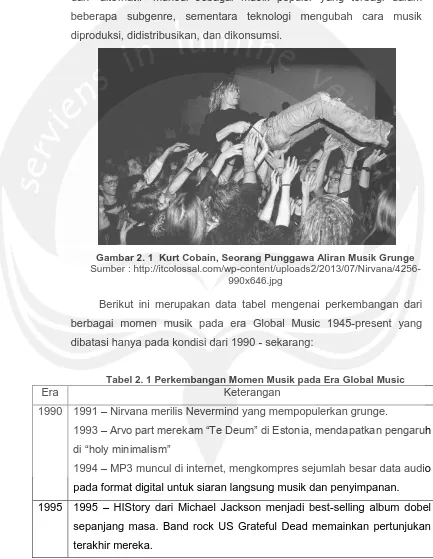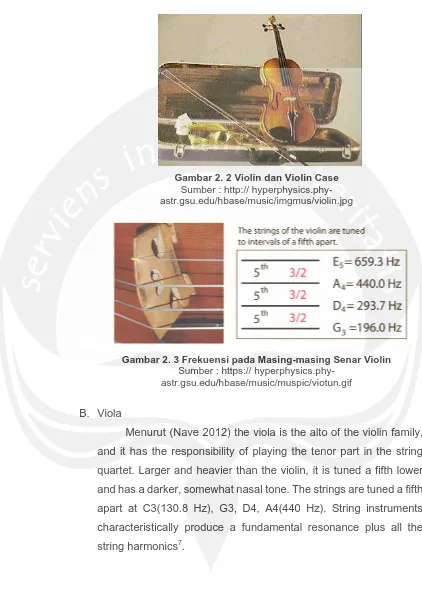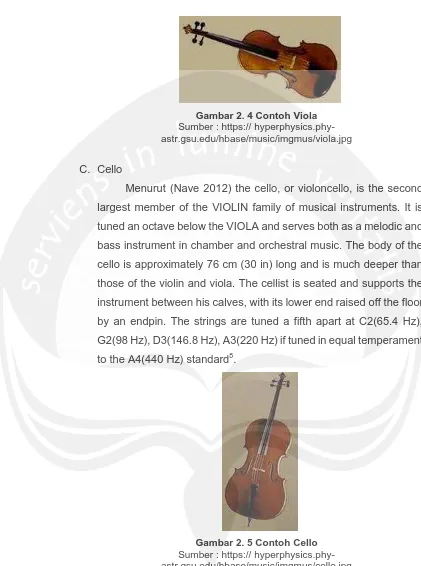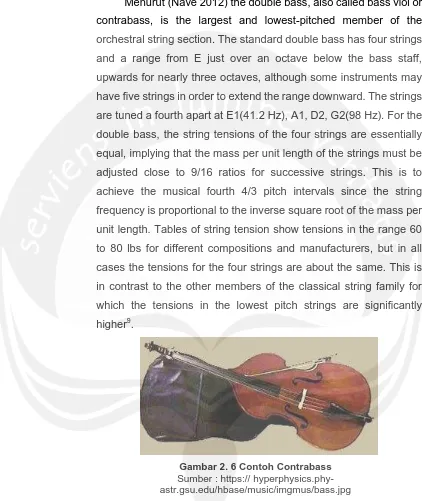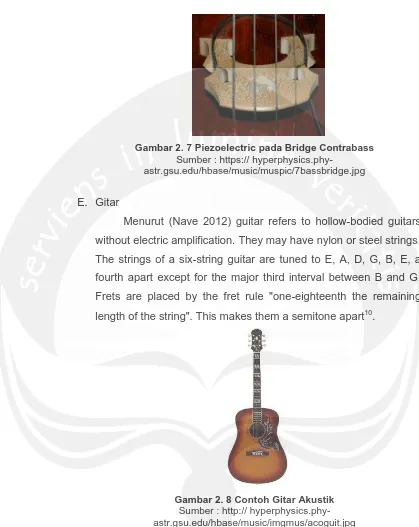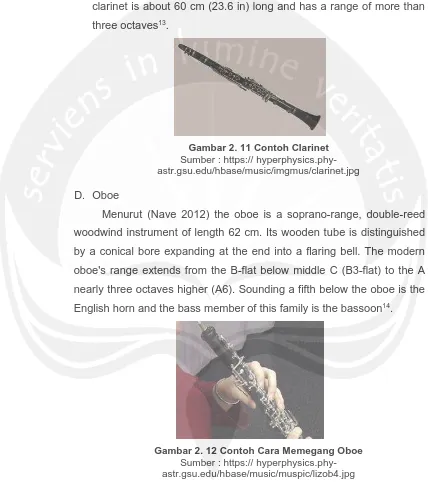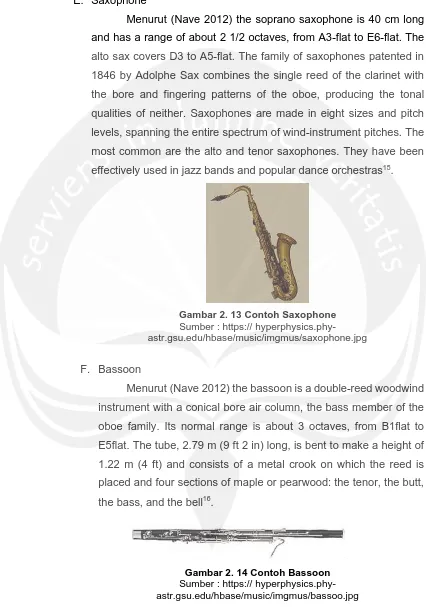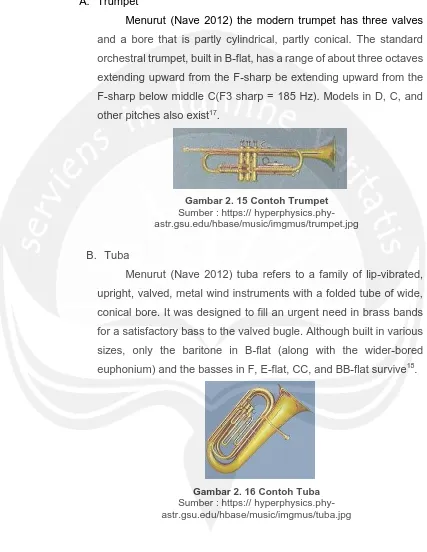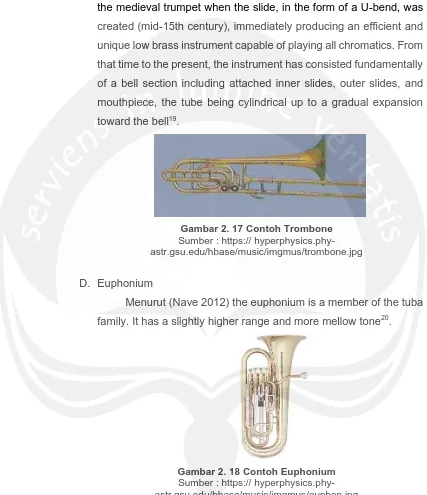8
BAB II
TINJAUAN PUSTAKA
2.1
Musik2.1.1
DefinisiMenurut (Jamalus 1988) p.1 Musik merupakan suatu hasil karya
seni berupa bunyi dalam bentuk lagu dan komposisi yang
mengungkapkan pikiran dan perasaan penciptanya melalui unsur-unsur
pokok musik yaitu irama, melodi, harmoni dan bentuk atau struktur lagu
serta ekspresi sebagai suatu kesatuan2.
2.1.2
SejarahMenurut (Smithsonian 2013) p.11 The earliest musical instrument
is one still used today— the human body. The drum, bone flute, and harp
were the earliest musical tools fashioned by humans. Whether in the form
of singing, clapping, or rhythmic pounding, music has always been used
to celebrate, praise, express sorrow and joy, to rally the troops or terrify
the enemy3. Instrumen musik era awal masih dipergunakan hingga hari
ini, yaitu tubuh manusia. Genderang, suling tulang, dan harpa,
merupakan instrumen musik era awal yang didesain oleh manusia.
Dalam bentuk bernyanyi, bertepuk tangan, atau menepukkan ritme,
musik selalu dipergunakan untuk merayakan, memuji, mengexpresikan
kesedihan maupun kegembiraan, dan untuk menyemangati pasukan
maupun menakuti musuh.
Menurut (Smithsonian 2013) p.4-6, sejarah musik dapat
diklasifikasikan menjadi 8 era yaitu 4:
A. Early Beginnings, 60.000 bce – 500 ce
B. Music in The Middle Ages, 500 – 1400
C. Renaissance and Information, 1400 – 1600
D. The Baroque Spirit, 1600 – 1750
2 Jamalus. 1988. Panduan Pengajaran Buku Pengajaran Musik melalui Pengalaman Musik. Jakarta: Proyek Pengembangan Lembaga Pendidikan . p.1
9
E. The Classical Age, 1750 – 1820
F. Nationalism and Romance, 1820 – 1910
G. Music in The modern Age, 1910 – 1945
H. Global Music, 1945 – present
2.1.3
PerkembanganMenurut (Smithsonian 2013) p.263 after World War II, the United
States captivated the world with the swaggering confidence of its popular
music. Jazz, blues, and rock’n’roll combined with radio television, and
hollywood movies to capture a global audience. Orchestral music and
opera continued to evolve in a dizzyingly diverse number of styles, and
“world” music gave a voice to the music of every country on earth5.
Setelah perang dunia kedua, Amerika Serikat menarik perhatian dunia
musik dengan kepercayaan diri dan keangkuhan mereka terhadap musik
populer. Jazz, blues, rock’n’roll yang dikombinasikan dengan radio,
televisi, film hollywood, mulai menangkap perhatian pemirsa global.
Musik orkestra dan opera melanjutkan berevolusi dengan
bermacam-macam gaya dan musik “dunia” memberikan suara terhadap musik dari
berbagai negara di dunia.
Menurut (Smithsonian 2013) p.265 The postwar period produced
classical, jazz, and popular music that challenged the notion of what
music actually was. Some modern classical composers and jazz artists
explored ever more intricate tonality and lyricism; others jettisoned
traditional musical values in pursuit of the new and provocative.
Rock‘n’roll linked youth-oriented popular music to an insubordinate subculture that alienated the older generation—as did punk and hip-hop.
The broad notion of “mainstream” and “alternative” music appeared as
popular music fragmented into a diverse array of subgenres, while
technology transformed the way music was produced, distributed, and
consumed. Era setelah perang menghasilkan klasik, jazz, dan musik
populer yang menantang untuk menghasilkan gagasan pada apa musik
yang sebenarnya. Beberapa komposer klasik modern dan artis jazz
10
mengexplorasi tone yang lebih rumit, nilai-nilai musik tradisional yang
mengejar aspek kontemporer dan provokatif. Rock’n’roll berorientasi
pemuda yang melawan subkultur dan mengasingkan generasi
pendahulu-seperti punk dan hip hop. Gagasan luas yang “mainstream”
dan “alternatif” muncul sebagai musik populer yang terbagi dalam
beberapa subgenre, sementara teknologi mengubah cara musik
diproduksi, didistribusikan, dan dikonsumsi.
Gambar 2. 1 Kurt Cobain, Seorang Punggawa Aliran Musik Grunge Sumber :
http://itcolossal.com/wp-content/uploads2/2013/07/Nirvana/4256-990x646.jpg
Berikut ini merupakan data tabel mengenai perkembangan dari
berbagai momen musik pada era Global Music 1945-present yang
dibatasi hanya pada kondisi dari 1990 - sekarang:
Tabel 2. 1 Perkembangan Momen Musik pada Era Global Music
Era Keterangan
1990 1991 – Nirvana merilis Nevermind yang mempopulerkan grunge.
1993 –Arvo part merekam “Te Deum” di Estonia, mendapatkan pengaruh
di “holy minimalism”
1994 – MP3 muncul di internet, mengkompres sejumlah besar data audio
pada format digital untuk siaran langsung musik dan penyimpanan.
1995 1995 – HIStory dari Michael Jackson menjadi best-selling album dobel
sepanjang masa. Band rock US Grateful Dead memainkan pertunjukan
11
1996 –Debut dari The Spice Girl “Wannabe” dirilis
1999 – Mamma Mia yang merupakan jukebox dari ABBA dibuka di
London.
2000 2001 – Toko musik online dari Apple yaitu iTunes dibuka untuk bisnis
2004 – Reality Talent Show yang berpengaruh The X Factor debut di UK
TV
2005 – YouTube yang merupakan website pertukaran video diluncurkan
2007 – Film High School Musical pertama dirilis
2008 – Website streaming musik Spotify diluncurkan
2012 – Video dari YouTube untuk Gangnam Styke dari Psy mulai
mendunia
2013 – Website milik David Bowie mengejutkan para fans dengan lagu
barunya setelah 10 tahun dan diperkenalkan di album pertamanya setelah
20 tahun.
Sumber : Smithsonian. 2013. Music - The Definitive Visual History. New York: DK Publishing. P.264-265. Diolah kembali oleh penulis September 2015
2.2
Instrumen Musik2.2.1
String Instruments A. ViolinMenurut (Nave 2012) the violin, the most commonly used
member of the modern string family, is the highest-sounding
instrument of that group. The strings are tuned a fifth apart at
G3(196 Hz), D4, A4, E5(659.3 Hz) using the A4 = 440Hz standard.
Strings characteristically produce a fundamental resonance plus all
the string harmonics. The sound of the instrument is enhanced by
body resonances including the air resonance of the f-holes6.
12
Gambar 2. 2 Violin dan Violin CaseSumber : http:// hyperphysics.phy-astr.gsu.edu/hbase/music/imgmus/violin.jpg
Gambar 2. 3 Frekuensi pada Masing-masing Senar Violin Sumber : https://
hyperphysics.phy-astr.gsu.edu/hbase/music/muspic/viotun.gif
B. Viola
Menurut (Nave 2012) the viola is the alto of the violin family,
and it has the responsibility of playing the tenor part in the string
quartet. Larger and heavier than the violin, it is tuned a fifth lower
and has a darker, somewhat nasal tone. The strings are tuned a fifth
apart at C3(130.8 Hz), G3, D4, A4(440 Hz). String instruments
characteristically produce a fundamental resonance plus all the
string harmonics7.
13
Gambar 2. 4 Contoh ViolaSumber : https:// hyperphysics.phy-astr.gsu.edu/hbase/music/imgmus/viola.jpg
C. Cello
Menurut (Nave 2012) the cello, or violoncello, is the second
largest member of the VIOLIN family of musical instruments. It is
tuned an octave below the VIOLA and serves both as a melodic and
bass instrument in chamber and orchestral music. The body of the
cello is approximately 76 cm (30 in) long and is much deeper than
those of the violin and viola. The cellist is seated and supports the
instrument between his calves, with its lower end raised off the floor
by an endpin. The strings are tuned a fifth apart at C2(65.4 Hz),
G2(98 Hz), D3(146.8 Hz), A3(220 Hz) if tuned in equal temperament
to the A4(440 Hz) standard8.
Gambar 2. 5 Contoh Cello Sumber : https:// hyperphysics.phy-astr.gsu.edu/hbase/music/imgmus/cello.jpg
14
D. Contra Bass
Menurut (Nave 2012) the double bass, also called bass viol or
contrabass, is the largest and lowest-pitched member of the
orchestral string section. The standard double bass has four strings
and a range from E just over an octave below the bass staff,
upwards for nearly three octaves, although some instruments may
have five strings in order to extend the range downward. The strings
are tuned a fourth apart at E1(41.2 Hz), A1, D2, G2(98 Hz). For the
double bass, the string tensions of the four strings are essentially
equal, implying that the mass per unit length of the strings must be
adjusted close to 9/16 ratios for successive strings. This is to
achieve the musical fourth 4/3 pitch intervals since the string
frequency is proportional to the inverse square root of the mass per
unit length. Tables of string tension show tensions in the range 60
to 80 lbs for different compositions and manufacturers, but in all
cases the tensions for the four strings are about the same. This is
in contrast to the other members of the classical string family for
which the tensions in the lowest pitch strings are significantly
higher9.
Gambar 2. 6 Contoh Contrabass Sumber : https:// hyperphysics.phy-astr.gsu.edu/hbase/music/imgmus/bass.jpg
Bridge pada instrumen contrabass memindahkan getaran dari
senar menuju plate di bagian atas instrumen. Bridge dilengkapi
dengan piezoelectric untuk memproduksi output elektrik yang dapat
diamplifikasikan.
15
Gambar 2. 7 Piezoelectric pada Bridge ContrabassSumber : https://
hyperphysics.phy-astr.gsu.edu/hbase/music/muspic/7bassbridge.jpg
E. Gitar
Menurut (Nave 2012) guitar refers to hollow-bodied guitars
without electric amplification. They may have nylon or steel strings.
The strings of a six-string guitar are tuned to E, A, D, G, B, E, a
fourth apart except for the major third interval between B and G.
Frets are placed by the fret rule "one-eighteenth the remaining
length of the string". This makes them a semitone apart10.
Gambar 2. 8 Contoh Gitar Akustik Sumber : http:// hyperphysics.phy-astr.gsu.edu/hbase/music/imgmus/acoguit.jpg
2.2.2
Woodwind Instruments A. FluteMenurut (Nave 2012) the flute is made in the form of an open
cylindrical air column about 66 cm long. Its fundamental pitch is middle C
16
(C4) and it has a range of about three octaves to C7. Sound is produced
from a flute by blowing onto a sharp edge, causing air enclosed in a tube
to vibrate. The flute as shown above is a transverse or side-blown flute11.
Gambar 2. 9 Orang Memainkan Flute Sumber : https:// hyperphysics.phy-astr.gsu.edu/hbase/music/muspic/saraflute.jpg
B. Piccolo
Menurut (Nave 2012) the piccolo, a transverse flute pitched an
octave above the concert or standard flute, is a development of the late
18th century. It is about 33 cm long and plays from D5 to B7-flat. Its range
is nearly three octaves, reaching the highest pitches in the modern
orchestra. It has a bright sound that can be heard easily, even in thickly
scored orchestral passages12.
Gambar 2. 10 Contoh Piccolo Sumber : https://hyperphysics.phy-astr.gsu.edu/hbase/music/imgmus/piccolo.jpg
C. Clarinet
Menurut (Nave 2012) the clarinet consists of a closed cylindrical
air column with a bell-shaped opening at one end. It's mouthpiece
holds a single reed, in contrast to the double reed of the oboe family.
It is typically constructed of wood. The traditional wood is an ebony
17
from Africa, Asia or South America commonly referred to as
grenadilla wood. Hard and black, this wood is capable of taking a high
polish. The instrument most commonly used today is known as the
B-flat clarinet; the next most common is the clarinet in A. The B-flat
clarinet is about 60 cm (23.6 in) long and has a range of more than
three octaves13.
Gambar 2. 11 Contoh Clarinet Sumber : https:// hyperphysics.phy-astr.gsu.edu/hbase/music/imgmus/clarinet.jpg
D. Oboe
Menurut (Nave 2012) the oboe is a soprano-range, double-reed
woodwind instrument of length 62 cm. Its wooden tube is distinguished
by a conical bore expanding at the end into a flaring bell. The modern
oboe's range extends from the B-flat below middle C (B3-flat) to the A
nearly three octaves higher (A6). Sounding a fifth below the oboe is the
English horn and the bass member of this family is the bassoon14.
Gambar 2. 12 Contoh Cara Memegang Oboe Sumber : https:// hyperphysics.phy-astr.gsu.edu/hbase/music/muspic/lizob4.jpg
18
E. Saxophone
Menurut (Nave 2012) the soprano saxophone is 40 cm long
and has a range of about 2 1/2 octaves, from A3-flat to E6-flat. The
alto sax covers D3 to A5-flat. The family of saxophones patented in
1846 by Adolphe Sax combines the single reed of the clarinet with
the bore and fingering patterns of the oboe, producing the tonal
qualities of neither. Saxophones are made in eight sizes and pitch
levels, spanning the entire spectrum of wind-instrument pitches. The
most common are the alto and tenor saxophones. They have been
effectively used in jazz bands and popular dance orchestras15.
Gambar 2. 13 Contoh Saxophone Sumber : https://
hyperphysics.phy-astr.gsu.edu/hbase/music/imgmus/saxophone.jpg
F. Bassoon
Menurut (Nave 2012) the bassoon is a double-reed woodwind
instrument with a conical bore air column, the bass member of the
oboe family. Its normal range is about 3 octaves, from B1flat to
E5flat. The tube, 2.79 m (9 ft 2 in) long, is bent to make a height of
1.22 m (4 ft) and consists of a metal crook on which the reed is
placed and four sections of maple or pearwood: the tenor, the butt,
the bass, and the bell16.
Gambar 2. 14 Contoh Bassoon Sumber : https:// hyperphysics.phy-astr.gsu.edu/hbase/music/imgmus/bassoo.jpg
19
2.2.3
Brass InstrumentsA. Trumpet
Menurut (Nave 2012) the modern trumpet has three valves
and a bore that is partly cylindrical, partly conical. The standard
orchestral trumpet, built in B-flat, has a range of about three octaves
extending upward from the F-sharp be extending upward from the
F-sharp below middle C(F3 sharp = 185 Hz). Models in D, C, and
other pitches also exist17.
Gambar 2. 15 Contoh Trumpet Sumber : https:// hyperphysics.phy-astr.gsu.edu/hbase/music/imgmus/trumpet.jpg
B. Tuba
Menurut (Nave 2012) tuba refers to a family of lip-vibrated,
upright, valved, metal wind instruments with a folded tube of wide,
conical bore. It was designed to fill an urgent need in brass bands
for a satisfactory bass to the valved bugle. Although built in various
sizes, only the baritone in B-flat (along with the wider-bored
euphonium) and the basses in F, E-flat, CC, and BB-flat survive18.
Gambar 2. 16 Contoh Tuba Sumber : https:// hyperphysics.phy-astr.gsu.edu/hbase/music/imgmus/tuba.jpg
20
C. Trombone
Menurut (Nave 2012) the trombone emerged as a variation of
the medieval trumpet when the slide, in the form of a U-bend, was
created (mid-15th century), immediately producing an efficient and
unique low brass instrument capable of playing all chromatics. From
that time to the present, the instrument has consisted fundamentally
of a bell section including attached inner slides, outer slides, and
mouthpiece, the tube being cylindrical up to a gradual expansion
toward the bell19.
Gambar 2. 17 Contoh Trombone Sumber : https:// hyperphysics.phy-astr.gsu.edu/hbase/music/imgmus/trombone.jpg
D. Euphonium
Menurut (Nave 2012) the euphonium is a member of the tuba
family. It has a slightly higher range and more mellow tone20.
Gambar 2. 18 Contoh Euphonium Sumber : https:// hyperphysics.phy-astr.gsu.edu/hbase/music/imgmus/euphon.jpg
21
E. French Horn
Menurut (Nave 2012) at 17 ft the longest of the brass
instruments except for the tuba. Piston valves and rotary valves.
Hand closure gives half step sharp, but physically it increases the
acoustic mass and lowers the resonance. The usual description
says that the hand closure makes the note closer to the next mode
up so that the column jumps to the next resonance during the hand
closure. The first valve lowers the pitch a whole step, the second a
half and third a step and a half. The Kruspe double horn has a horn
in F and a horn in B, adding about another three feet to the column21.
Gambar 2. 19 Contoh French Horn Sumber : https://
hyperphysics.phy-astr.gsu.edu/hbase/music/imgmus/FrenchHorn.jpg
F. Flugelhorn
Menurut (Nave 2012) the flugelhorn is a valved bugle
developed in Germany. It has a conical bore. The bugle had no
valves and therefore could produce only the natural harmonics of
the tube. The design pitch was was typically middle C or B-flat. The
flugelhorn has a mellower sound than the trumpet22.
Gambar 2. 20 Contoh Flugelhorn Sumber : https:// hyperphysics.phy-astr.gsu.edu/hbase/music/imgmus/flugel.jpg
22
2.2.4
Percussion InstrumentsA. Timpani
Menurut (Nave 2012) the timpani has a round head stretched over
a sealed enclosure. The tension may be altered by means of a footpedal
which actuates tensioning elements23.
Gambar 2. 21 Contoh Timpani Sumber : https:// hyperphysics.phy-astr.gsu.edu/hbase/music/imgmus/timpan.jpg
B. Snare Drums
Menurut (Nave 2012) the snare drum is a two-headed drum, as is
the bass drum and other orchestral and band drums used in Western
music. On the snare drum, eight to ten wire-bound gut strings, or snares,
usually are stretched across the lower of the two heads; they vibrate
against the heads as the membranes are struck. The two membranes of
the snare drum are acoustically coupled to each other, particularly at the
low frequencies. This coupling via the enclosed air acts to double the
modes. The lower frequency member of the mode pair involves both
heads moving in the same direction and for the higher mode they move
oppositely24.
23
Gambar 2. 22 Contoh Snare DrumsSumber : https://
hyperphysics.phy-astr.gsu.edu/hbase/music/imgmus/snaredrum.jpg
C. Marimba
Menurut (Nave 2012) the playing range of a concert marimba is A2
to C7 (110 to 2093 Hz) and bass marimbas extend down to C2 (65 Hz).
The undercutting of the bars on the marimba produce overtones which
are described as two octaves up, and then three octaves plus a minor
third. Two octaves is the fourth harmonic, and the other overtone is close
to the 10th harmonic (48/5 if just intervals are used). These upper
resonances are not reinforced by the closed tube resonator since it
produces only odd harmonics25.
Gambar 2. 23 Contoh Marimba Sumber : https:// hyperphysics.phy-astr.gsu.edu/hbase/music/imgmus/xyloph.jpg
D. Bells
Menurut (Nave 2012) some of the commonly used bells are church
bells, carillion bells, and handbells. Carillion bells have eight modes of
vibration which contribute to the tone. Handbells, struck with a soft
internal clapper, have a 2,0 mode which is the strike tone. The 3,0 mode
is tuned to three times the frequency of the 2,0 mode and the 2,0 mode
24
produces some second harmonic, so you have sound at the first three
harmonics. Rossing (p283) shows hologram interferograms of 17 modes
of a C5 (523 Hz) handbell26.
Gambar 2. 24 Contoh Bell Sumber : https:// hyperphysics.phy-astr.gsu.edu/hbase/music/imgmus/hbell.jpg
E. Lyra Glockenspiel
Menurut (Nave 2012) the glockenspiel makes use of the free bar
modes .They are not a harmonic sequence, but the fundamental mode
produces a clear, bell-like tone. Sometimes called "orchestra bells", the
glockenspiel has rectangular bars 1 in to 1 1/4 in wide and 5/16 to 3/8
thick. A typical range is G5 (784 Hz) to C8 (4186 Hz), matching the top
end of the piano. When played with brass or plastic mallets, a sharp
attack is produced followed by a clear, ringing sound at the designed
pitch. The upper bar modes, which are not harmonics of the fundamental
pitch, die away quickly27.
Gambar 2. 25 Contoh Lyra Glockenspiel Sumber : https:// hyperphysics.phy-astr.gsu.edu/hbase/music/imgmus/glock.jpg
26 Nave, Carl Rod. 2012. HyperPhysics. Diakses Oktober 2, 2015. hyperphysics.phy-astr.gsu.edu/bell
27 Nave, Carl Rod. 2012. HyperPhysics. Diakses Oktober 2, 2015.
25
F. Tubular Bells
Menurut (Nave 2012) a bell-like sound can be obtained by tuned
metal tubes. They are commonly referred to as bells or chimes. A similar
instrument is constructed of metal bars. The set of hollow vertical pipes
is suspended at the top of the pipes by thin wire. Each pipe is struck with
hammers on the top part of the chime. The three lowest modes of
vibration of a chime tube have frequencies with ratios 2:3:4. The ear
perceives this as the pitch one octave below the fundamental by the
missing fundamental effect. Other overtones depart from this
approximate linear set of harmonics and help give the chime its unique
sound. There are end plugs which are said to add to the sustain of the
tone and to damp out high harmonics. The end plug helps to lower the
frequencies of the first few modes, but has little effect on higher modes28.
Gambar 2. 26 Contoh Tubular Bells Sumber : https:// hyperphysics.phy-astr.gsu.edu/hbase/music/imgmus/tbell.jpg
G. Cymbal
Menurut (Nave 2012) cymbals produce a dramatic percussive
sound when struck; several modes of vibration of the thin metal are
excited. Since the vibrational modes of the metal circle are not harmonics,
there is a less-definite sense of pitch that that of most orchestral
instruments for which the fundamental pitch is reinforced by the missing
fundamental effect29.
26
Gambar 2. 27 Contoh CymbalSumber : https:// hyperphysics.phy-astr.gsu.edu/hbase/music/imgmus/cymbl2.jpg
H. Bass Drum
Menurut (Nave 2012) the bass drum usually has a diameter of
50-100 cm and membranes on both ends of the cylindrical body. Although
the drum does not have a well-defined pitch center, it is common practice
to tune the lowest modes of the two heads about a musical fourth apart.
The coupling between the two heads of the drum produces a splitting of
the two lowest modes, the 0,1 and 1,1 modes30.
Gambar 2. 28 Contoh Bass Drum Sumber : https:// hyperphysics.phy-astr.gsu.edu/hbase/music/imgmus/bdrum.jpg
I. Drum Kit
Menurut (Nave 2012) a bass drum, snare drum, two toms, two
cymbals and one pedal- operated "high-hat" pair of cymbals. The main
differences between drums are their dimensions, the wood they are made
of, and teh consistency of the bearing edge. The preferred wood is maple,
but mahogany and birch are also used31.
27
Gambar 2. 29 Contoh Drum KitSumber : https:// hyperphysics.phy-astr.gsu.edu/hbase/music/imgmus/drumkit.jpg
2.2.5
Piano and Others A. PianoMenurut (Nave 2012) this baby grand is one of several
configurations of the piano. The piano has 88 keys which span the
frequency range 27.5 Hz (A0) to 4186 Hz (C8). The strings are sounded
by hammer mechanisms which are activated by the keys. The relatively
soft hammer structure, fashioned from pressurized wool, gives a dramatic
attack to the tone without sounding harsh32.
Gambar 2. 30 Contoh Piano Sumber : https:// hyperphysics.phy-astr.gsu.edu/hbase/music/imgmus/piano.jpg
28
B. Harpsichord
Menurut (Nave 2012) a stringed keyboard instrument developed
during the 14th and 15th century, the harpsichord was widely used until
the early 19th century when it was superseded by the piano. 20th century
revivals of the instrument feature music of the 16th to 18th centuries with
particular emphasis on Bach's music. The metal strings are sounded by
plucking with a small piece of material called a plectrum which is attached
to the key mechanism. A downward stroke on the key raises the plectrum
on the other end so that it plucks the string and then pivots so that it does
not touch the string on the way down33.
Gambar 2. 31 Contoh Harpsichord Sumber : https:// hyperphysics.phy-astr.gsu.edu/hbase/music/imgmus/harpsi.jpg
C. Organ
Menurut (Nave 2012) the traditional pipe organ is a collection of
tuned pipes which are sounded by admitting air to them from a windchest.
The centuries of development of the pipe organ have yielded a rich
variation in types of pipes as well as mechanisms for sounding them. The
collection of pipes of a given type is called a rank, and the organist's
control knob for a rank is called a "stop". "Pulling the stop" means opening
the valve to let air into that rank of pipes (when the corresponding key on
the keyboard is pressed). Some of the largest organs have more than a
hundred ranks34.
29
Gambar 2. 32 Contoh OrganSumber : https:// hyperphysics.phy-astr.gsu.edu/hbase/music/imgmus/organ.jpg
2.2.6
Intensitas dan Frekuensi Instrumen MusikSetiap instrumen musik memiliki intensitas dan frekuensi tersendiri.
Frekuensi dari masing-masing instrumen musik didasarkan pada rentang
dari pitch yang dimiliki. Instrumen musik saat ini yang memiliki rentang
frekuensi paling jauh adalah piano yang memiliki 88 nada dan terbagi dari
30Hz hingga 4kHz dalam solmisasi A0 hingga C8. Piano sendiri
merupakan perkembangan dari harpsichord dan clavichord yang memilik
rentang frekuensi lebih kecil sebesar 61 nada dan terbagi dari 120 Hz
hingga 2kHz dalam solmisasi C2 hingga C7. Pada zaman renaissance
ketika opera mulai dimainkan instrumen musik pada era itu
menyesuaikan frekuensi dari harpsichord sehingga kebanyakan dari
instrumen string, woodwind, brass, dan percussion memiliki rentang
nada sebanyak 2-3 oktaf dan berada pada kisaran rentang nada
harpsichord.
Untuk paduan suara atau yang biasa disebut choir sendiri terbagi
dari C2 hingga F6 dalam klasifikasi karakter suara dari suara tenor
30
Gambar 2. 33 Rentang Frekuensi pada Instrumen MusikSumber : http://www.music-academy.net/instruments-frequencies/img0024.jpg
Intensitas yang dimiliki oleh tiap instrumen musik mengharuskan
setiap orkestra memiliki kemampuan untuk mengontrol kapabilitas setiap
instrumen musik yang dimiliki sehingga tidak memproduksi nois yang
berlebih. Berikut ini merupakan tabel yang mengindikasikan intensitas
31
Tabel 2. 2 Intensitas Instrumen MusikSOURCE dB Peak
Single musicians
Violin/viola (near left ear) 85 - 105 116 Violin/viola 80 - 90 * 104
Cello 80 - 104 * 112
Acoustic bass 70 - 94 * 98 Clarinet 68 - 82 * 112
Oboe 74 - 102 * 116
Saxophone 75 - 110 * 113
Flute 92 - 105 * 109
Flute (near right ear) 98 - 114 118 Piccolo 96 - 112 * 120 Piccolo (near right ear) 102 - 118* 126 French horn 92 - 104 * 107 Trombone 90 - 106 * 109 Trumpet 88 - 108 * 113
Harp 90 111
Timpani and bass drum 74 - 94 * 106 Percussion (high-hat near left ear) 68 - 94 125 Percussion 90 - 105 123-134
Singer 70 - 85 * 94
Soprano 105 - 110 118
Choir 86 No data
Normal piano practice 60 - 90 * 105 Loud piano 70 - 105 * 110 Keyboards (electric) 60 - 110 * 118 Several musicians
Chamber music (classical) 70 - 92 * 99 Symphonic music 86 - 102 * 120 - 137
* at 3 m
Sumber : http://www.soundadvice.info/thewholestory/san12/ , diolah kembali oleh penulis November 2015
Selain pengontrolan intensitas dari masing-masing instrumen
sendiri sebenarnya kondisi nois yang dihasilkan juga mampu merusak
32
jumlah waktu maksimal yang dapat ditoleransi sebelum intensitas dari
instrumen musik mempengaruhi kesehatan. Berikut ini merupakan data
tabel mengenai batasan waktu yang dapat ditoleransi untuk setiap nois
pada beberapa tingkat desibel :
Tabel 2. 3 Batas Waktu Toleransi Nois Instrumen Musik
dB
82 16 hours eg violin 85 8 hours eg harp 88 4 hours eg trumpet
91 2 hours eg trombone/French horn 94 1 hour eg loud piano
97 30 minutes eg loud soprano 100 15 minutes
103 7.5 minutes 137 dB (peak) Maximum
instantaneous peak noise when wearing hearing protection
Note that the peak noise from percussion, e.g. snare drum or cymbal clash, may exceed the 137 dB upper exposure action value.
Sumber : http://www.soundadvice.info/thewholestory/san12/ , diolah kembali oleh penulis November 2015
Berdasarkan data di atas instrumen musik sendiri memiliki
intensitas yang berbeda dan frekuensi yang berbeda. Kondisi perbedaan
tersebut mempengaruhi akumulasi kemampuan manusia agar tetap
berada dalam kondisi prima saat memainkan instrumen musik. Ketika
instrumen musik dimainkan dalam ruangan yang akomodatif terhadap
intensitas dan frekuensi yang sesuai maka hasil musikal dari tiap
instrumen akan berada pada kondisi tepat sasaran. Berikut ini data tabel
mengenai klasifikasi instrumen musik berdasarkan intensitas dan
33
Tabel 2. 4 Klasifikasi Instrumen Musik berdasarkan Intensitas danFrekuensi Intensitas Tinggi Frekuensi Tinggi Intensitas Tinggi Frekuensi Rendah Intensitas Rendah Frekuensi Tinggi Intensitas Rendah Frekuensi Rendah
euphonium trumpet flute bassoons
flugelhorn trombone piccolo cello
french horn tuba clarinet viola
saxophone contrabass oboe
marimba timpani violin
cymbal snare drums
lyra glockenspiel organ
tubular bells
piano
harpsichord
Sumber : Analisis Penulis, November 2015
2.3
Amphitheater2.3.1
DefinisiMenurut (Paramita 2013) p.1 Ruang Konser dapat berarti ruang di
mana tempat konser musik berlangsung seperti musik orkestra,
gamelan, paduan suara, angklung, band, music barat dan music
tradisional lainnya35. Pada efektifitasnya sebagai bangunan, bangunan
konser merupakan bangunan yang tidak hanya mempertunjukan musik
tapi juga bangunan yang memerlukan pertimbangan mengenai musisi,
teknisi, manajemen, yang diintegrasikan dalam bangunan baik secara
internal maupun eksternal.
34
Gambar 2. 34 Ruang Konser pada Red Rock AmphitheaterSumber :
https://blogs.chapman.edu/wp-content/uploads/sites/26/2013/12/britfloyd-765x510.jpg
Berdasarkan sifatnya bangunan konser dapat dipisah menjadi 2
sistem yaitu ruang tertutup dan ruang terbuka. Bangunan konser pada
ruang tertutup merupakan bangunan konser dengan format auditorium di
mana ruangan tertutup secara keseluruhan menggunakan material
khusus. Contoh bangunan konser dengan sistem ruang tertutup adalah
Walt Disney Concert Hall. Bangunan konser pada ruang terbuka
merupakan bangunan konser dengan format amphiteater di mana ruang
konser merupakan ruang terbuka dengan panggung dan area tempat
duduk solid dan biasanya dari material alami. Contoh bangunan konser
dengan sistem terbuka adalah Amphiteater Taman Budaya Yogyakarta.
2.3.2
FungsiAmphitheater menampilkan kegiatan pertunjukan musik sehingga
fungsi dari amphitheater merupakan media pengungkapan musik
terhadap masyarakat. Sebagai bagian dari kesenian musik memiliki
fungsi sosial yang secara universal dapat ditemukan dalam berbagai seni
budaya yang terdapat di dunia. Berikut ini merupakan fungsi pertunjukan
musik menurut (Merriam 1964) p.300 36:
A. The function of emotional ( Fungsi pengungkapan
emosional)
35
B. The function of aesthetics enjoyment ( Fungsi kenikmatan
estetis )
C. The function of entertainment ( Fungsi hiburan )
D. The function of communication ( Fungsi komunikasi )
E. The function of symbolic representation ( Fungsi
pengungkapan simbolis )
F. The function of physical response ( Fungsi respon fisik )
G. The function of enforcing conformity to social norm ( Fungsi
penguatan konformitas terhadap norma-norma sosial )
H. The function of validation of social institutions and religious
vital ( Fungsi validasi tentang institusi sosial dan ritual
keagamaan )
I. The function of contribution to the continuity and stability of
culture ( Fungsi kontribusi terhadap kontinuitas dan
stabilitas dari kebudayaan )
J. The function of contribution to the integration of society (
Fungsi kontribusi pada integrasi dalam masyarakat )
Dengan tercapainya fungsi dari pertunjukan musik dalam suatu
amphitheater maka amphitheater tersebut secara tidak langsung
menjalankan berbagai fungsi dari pertunjukan musik.
2.3.3
Ciri-ciri KhasUntuk amphitheater modern memiliki ciri-ciri khas sebagai berikut :
A. Berbentuk setengah lingkaran
Bentuk amphiteater modern yang berpola setengah
lingkaran merupakan hasil adaptasi dari kondisi
masyarakat. Sistem audio dan efektivitas area penglihatan
performer membuat sistem panggung lingkaran pada era
modern menjadi tidak efektif.
B. Memilki tempat duduk bertingkat
Tempat duduk pada amphiteater modern tidak begitu jauh
36
C. Tempat duduk terletak di satu sisi
Peletakan tempat duduk pada satu sisi saja disebabkan
oleh efektivitas area penglihatan performer yang tidak
mampu menjangkau 3600 pada satu waktu.
Berikut ini merupakan contoh dari amphitheater modern yang
digunakan untuk konser :
Gambar 2. 35 Vetter Stone Amphitheater
Sumber : http://visitgreatermankato.com/wp-content/uploads/2013/11/60-Outdoor-concert-Riverfront-Park.jpg
2.3.4
FasilitasMenurut (Chiarra 1983) p.377-378 terdapat 6 fasilitas utama yang
wajib diakomodasi pada amphitheater yaitu 37:
A. Outside The Theater
Merupakan area yang terdiri dari tempat parkir, tempat
pembelian tiket, ruang kesehatan, dan gerbang utama.
B. The Auditorium
Merupakan area bagi para penonton yang terbagi dalam
beberapa format
C. The Stages
Merupakan area bagi para penampil untuk menampilkan
karya mereka
37
D. The Backstage Area
Merupakan area persiapan bagi para penampil sebelum
menampilkan karya mereka
E. The Dressing Rooms
Merupakan ruang ganti pakaian untuk para penampil, bisa
juga dikombinasikan dengan ruang tunggu sebelum
penampil mempersiapkan diri di ruang backstage.
F. Shops and Offices
Merupakan ruang komersil pada bangunan untuk keperluan
merchandise maupun urusan administrasi bangunan.
2.4
Studi Preseden2.4.1
Hellenistic Theater of EpidaurusMenurut (Declerq dan Dekeyer 2007) p.2011 The Hellenistic
theater of Epidaurus, on the Peloponnese in Greece, attracts thousands
of visitors every year who are all amazed by the fact that sound coming
from the middle of the theater reaches the outer seats, apparently without
too much loss of intensity 38. Hellenistic theater di Epidaurus mampu
menarik perhatian pengunjung tiap tahun karena terkesima dengan fakta
bahwa suara yang datang dari tengah teater dapat mencapai tempat
duduk paling luar tanpa kehilangan banyak intensitas.
38
Gambar 2. 36 Hellenistic Theater di EpidaurusSumber : http://www.j-g.gr/wp-content/gallery/epidaurus-festival/epidaurusfestival-5.jpg
Kualitas akustik yang ada pada teater dipengaruhi oleh geometri.
Menurut (Declerq dan Dekeyer 2007) p.2012 geometrical properties of
the theater that are important for the acoustics. The theater is almost
semicircular. This means that the acoustics, for a sound source situated
at the center of the theater, will have a circular symmetry similar to the
theater itself 39. Kondisi geometri dari teater penting untuk akustik. Teater
berbentuk hampir setengah lingkaran. Kondisi ini menyatakan bahwa
sistem akustik, untuk sumber suara di tengah teater akan memiliki simetri
lingkaran mirip dengan bentuk teater itu sendiri.
39
Gambar 2. 37 Kondisi Geometri Lingkaran Hellenistic Theater Sumber :http://images.fineartamerica.com/images-medium-large-5/amphitheatre-at-epidaurus-2-deborah-smolinske.jpg
Kondisi permukaan tempat duduk juga mempengaruhi kualitas
akustik dengan sistem perangkap akustik alami. Menurut (Chao 2007)
The corrugations on the surface of the seats act as natural acoustic traps.
Though this effect would seem to also remove the low frequencies from
the actors' voices, listeners actually fill in the missing portion of the audio
spectrum through a phenomenon known as virtual pitch. The human
brain reconstructs the missing frequencies, producing the virtual pitch
phenomenon, as in listening to someone speaking on a telephone with
no low end. Kondisi tempat duduk menjadi perangkap akustik alami
walaupun kondisi tempat duduk juga mengakibatkan sumber suara
kehilangan beberapa frekuensi. Kondisi kehilangan frekuensi tersebut
sebenarnya mampu diolah oleh otak manusia karena kondisi kehilangan
frekuensi tersebut sama dengan frekuensi suara yang biasa kita dengar
40
Gambar 2. 38 Kondisi Tempat Duduk Hellenistic TheaterSumber : https://upload.wikimedia.org/wikipedia/commons/d/d7/07 Epidaurus_Theater09.jpg
2.4.2
Amphiteater Taman Budaya YogyakartaTaman Budaya Yogyakarta yang memiliki visi sebagai “The Window of Yogyakarta” merupakan kompleks pusat pengembangan
kebudayaan daerah Yogyakarta di bawah Dinas Kebudayaan dan
Pariwisata Provinsi DIY. Saat ini TBY menjadi tempat dilangsungkan
aneka kegiatan seni budaya (teater, musik, tari, pameran), hingga
bimbingan dan pelatihan seni untuk anak dan remaja. Selain memiliki
gedung pertunjukan, gedung pameran dan amphiteater, di kompleks
TBY juga terdapat kantin, mushola dan perpustakaan.
Amphiteater TBY memiliki geometri persegi panjang dengan
tempat duduk penontong bertingkat menghadap ke arah panggung.
Amphiteater TBY memiliki atap yang disambungkan dengan konstruksi
space frame. Sistem suara di Amphiteater TBY menggunakan sound
system temporer menyesuaikan kebutuhan akustik tiap acara yang
berlaangsung.
Amphiteater TBY memiliki masalah pada sistem sound di mana
posisi foh kerap kali terletak di antara penonton sehingga menimbulkan
kesulitan ketika beberapa kelompok musik memiliki soundman sendiri.
Proses pergantian operator di amphiteater TBY kurang mengakomodasi
41
pengaturan akustik pada operator yang kerap kali belum mengenal
karakteristik suara dari kelompok musik yang terkait.
Kondisi latar panggung di Amphiteater TBY dirancang sederhana
dengan pemberian batu alam yang disusun sejajar. Panggung tersebut
terkadang memerlukan tambahan cahaya buatan. Lampu sebagai
cahaya buatan yang terdapat pada Amphiteater TBY sulit dijangkau
dalam proses pengolahan tata cahaya sehingga kondisi tata cahaya
[image:34.595.86.512.154.704.2]dalam beberapa konser kerap kali mengalami kemonotonan visual.
